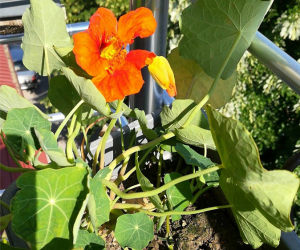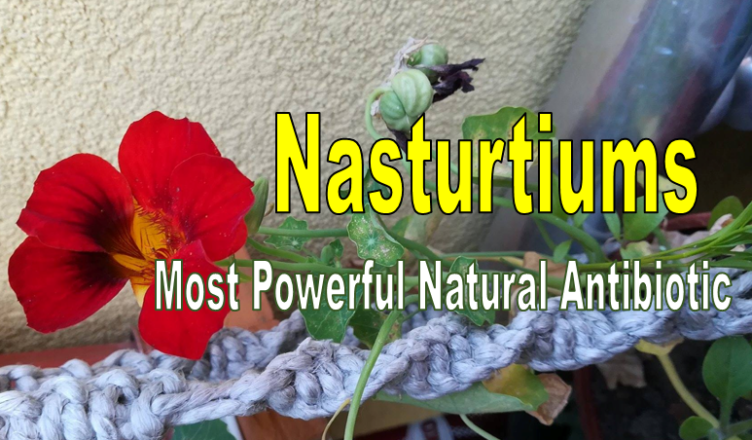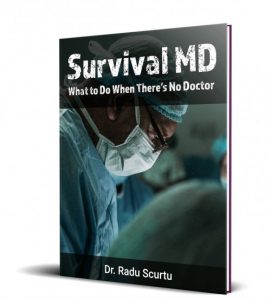Nasturtiums or Tropaeolum majus are one of the most popular summer plants and they are not only beautiful and decorative, but also extremely healing and powerful natural antibiotics.
It originally came from South America – Bolivia, Ecuador, Colombia and Peru, where it was long used for the treatment of wounds. The local residents placed it on the wounds and thus prevented infections. In the 16th century was brought in Europe. Nasturtiums are annual plants grown principally as an ornamental and to a lesser extent for their edible leaves, flowers, and buds.
The Incas knew about the medicinal value of these flowers and used them in salads, as can be done today. Many people do not realize the vast number of uses and health benefits of nasturtiums in today’s society. Nasturtium flowers are edible just like marigold, kachnar, viola and daisy flowers.
The name nasturtium means “nose twisted” and it comes from the Latin nasum, nose and torquere to twist.
Tropaeolum majus is also known as Indian cress, Capuchin cress, or Monk’s cress. They reseed and grow easily if left to do so, and are very decorative plants and useful too if you plant them between vegetables as they repel ants, aphids, and flies.
The leaves are almost round, on long handles and with significant marbling. The flowers are large, with conspicuous orange color, and dotted with red stripes. The fruit is dry, divided into three parts, each has one seed.
Flourishes in summer. The whole above-ground parts of the plant are edible and can be used for medicinal purposes including the mature seeds. Nasturtiums contain flavonoids such as isoquercitrin and kaempferol, vitamin C, carotenoids, the minerals sulfur, manganese, iron, and amino acids. They have antiseptic properties and act as a mild laxative and diuretic.
The Health Benefits of Nasturtiums
Nasturtium is one of the most powerful natural antibiotics and also has antifungal, antiseptic properties. A 2009 study by the National University of Colombia identified the group of phenols or phenolic compounds in the pigments of red and orange flowers of Tropaeolum majus as anthocyanins. Anthocyanins, which are abundant in red cabbage and blueberries, help naturalize the damaging effects of free radicals, thereby helping to protect us from chronic diseases such as cancer and cardiovascular disease. Anthocyanins are antioxidant, anti-inflammatory, antimicrobial, and anticancer. (1)
In folk medicine, Nasturtium has been proven that can be used for the treatment of:
- Respiratory system diseases: asthma, bronchitis, excessive mucus, inflammatory diseases, cough, cold, flu, emphysema;
- Kidney diseases, urinary tract diseases, such as inflammatory conditions and infections, urinary incontinence;
- Diseases of hair and scalp;
- Skin disorders, various skin injuries, skin impurities, burns, rashes

- Diseases of the liver and bile – poor performance and poor secretion.
- Inflammation and diseases of the eye
- Regulating menstruation
- Diabetes
- Boosting sex drive in men
- Boosting physical and mental energy
- Treatment of cancer
For respiratory system diseases, you can use tincture – one teaspoon three times a day, diluted with 100 ml of water. For every 100 ml of 96% strong alcohol add one tablespoon of chopped wild nasturtium, and leave it to steep for 6-8 days. Filter it and store it in a clean and sterilized bottle.
You can also use nasturtium seeds. Add some water to finely ground 5 to 10 g of nasturtium seeds. Leave it to steep for two hours then drink it with a fruit juice.
Eating a couple of the peppery leaves at the onset of a cold can stop it dead in its tracks.
Every household should cultivate nasturtiums, even those who do not have a garden because they can be easily grown on the balcony or inside as long as they get full sunlight. Like all other plants with sulfur Heterozoids and vitamin C, nasturtium too has great significance as a preventive agent, because the nasturtium essential oil contains a high concentration of sulfur which destroys many infectious germs.
Tincture against hair loss
- 100 g of fresh nasturtium leaves
- 100 g nettle
- 100 g boxwood leaves
- 2.1 liter of alcohol
Finely chop all the ingredients and place them in large glass jar. Add the alcohol, close it tight and leave it for 15 days, but be sure to shake it once a day. Then strain the mixture through cheesecloth. Apply the tincture with a soft brush on your scalp and hair once a day for three weeks. Leave it on for one hour then rinse it with lukewarm water.
Also, you can mix one cup each of nasturtiums, rosemary, and nettle into two liters of water. Simmer in a closed pot for 15 minutes. Leave it to cool and then strain for use. Massage into scalp before rinsing out.
Vitamin Salad
- Nasturtiums leaves
- Lemon juice
- Salt
- Olive oil
Finely chop the leaves, add the lemon juice, salt, olive oil and mix well.
Bath
For various skin diseases are recommended complete baths with nasturtium.
Tea for skin and eye diseases
- 1 teaspoon of leaves – 200 ml water (one cup)
In one cup of boiling water add one teaspoon of nasturtium leaves. Cover and let it steep for 30 minutes then strain. Drink 2-3 cups a day.
For coating and washing put in 1 teaspoon of nasturtium leaves in 200 ml water.
- Eating a couple of leaves a day can help clear up acne.
For treatment of cancer
- 200 g of whole plants with flowers and 1-liter water
Wash and chop the herbs, add the water and cover. Strain it well after 12 hours. Take 1-3 tablespoons a day, with some water or tea.
Do not eat flowers purchased at flower shops because they have probably been treated with chemical sprays. Instead, buy them from the grocery, or if you grow your own use a hose to spray off caterpillars and aphids, which are common pests attracted to nasturtium.
You should not use continuously for an extended period of time. You may take the remedy daily for no longer than a week at a time, giving it a break for at least a week before continuing again.
DISCLAIMER: This article is not intended to provide medical advice, diagnosis or treatment.
source:naturalblaze









